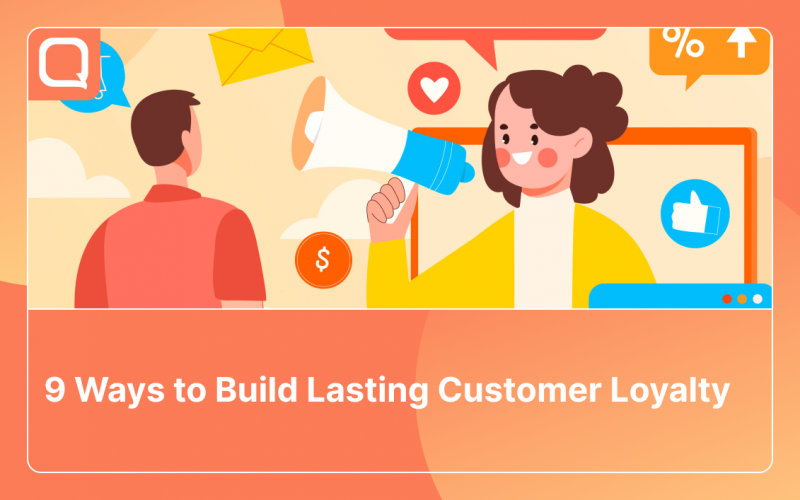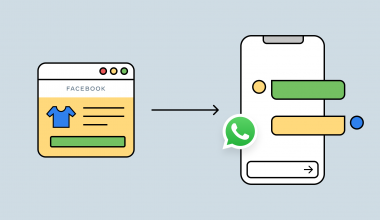The paradigm of building customer loyalty is continuously evolving. Today, simply offering product discount vouchers is insufficient. Building customer loyalty now encompasses much more, particularly in fostering an emotional connection with our consumers.
This shift is influenced by advancements in technology, prevailing trends, and the ever-evolving needs of consumers. In the past, discounts and vouchers were highly valued due to their rarity and exclusivity. However, nowadays, many brands regularly offer discounts to attract and retain customers.
Discounts can only foster short-term customer loyalty. When discussing customer loyalty, we refer to the long-term relationship between a brand and its consumers. This relationship goes beyond mere transactions, involving an exchange of intangible value.
READ MORE: The Truth About WhatsApp Business: Advantages and Disadvantages
Understanding Customer Loyalty

Customer loyalty is the commitment shown by customers following the establishment of a positive relationship with a brand. This is reflected in repeat purchases, referrals, and brand advocacy. In simple terms, customer loyalty is not just about consistent sales and existing customers but also about enhancing a business’s brand image.
Customer Lifetime Value (CLTV) is a crucial indicator for understanding customer loyalty. CLTV helps you determine how to build long-lasting customer loyalty. The purpose of CLTV is to measure and demonstrate the value of the relationship between consumers and a brand. By focusing on CLTV, you can identify which customers should be prioritized and which customers are merely seeking benefits such as discounts and consumer points.
Key elements of CLTV that you should be aware of include the following.
1. Purchase Frequency
Purchase frequency refers to how often customers buy your products. You can create a matrix ranging from daily, weekly, monthly, to yearly intervals. A high purchase frequency indicates a high level of customer engagement with your brand.
It is crucial to identify and understand this metric promptly, so you can respond with relevant and valuable rewards for your loyal customers.
2. Average Purchase Value
This metric represents the average amount of money customers spend each time they transact with your company. It can be calculated by dividing the total revenue from customers by the number of transactions they make.
Understanding the Average Purchase Value (APV) helps you segment your loyal customers. This segmentation allows you to devise appropriate strategies or rewards to maintain their loyalty based on the value of their transactions.
3. Customer Retention Rate
This is an important metric to gauge the level of customer loyalty over a specific period. The customer retention rate also reflects customer satisfaction with your products and services. If customers are satisfied, the retention rate increases, and vice versa.
4. Customer Lifespan
Customer lifespan measures how long a customer remains with your brand. This timeframe helps you understand the potential value you can derive from customers, with the expectation that they will receive equal value from your brand over the same period.
5. Customer Acquisition Cost
This is the average cost incurred by the company to acquire a new customer. Lower customer acquisition costs allow the company to allocate more resources to retaining existing customers.
These elements are interrelated and contribute to the calculation of CLTV. By understanding and optimizing each of these components, companies can enhance their overall CLTV and build more profitable relationships with their customers.
READ MORE: How to Secure Your WhatsApp Business Account: 7 Vital Steps!
Strategies for Building Customer Loyalty
Building customer loyalty is challenging and requires the right pillars or strategies to reap the benefits. Here are several key approaches to building customer loyalty:
1. Personalize Customer Experience
Start by improving your customer experience. One indicator of poor customer experience is a high bounce rate on your landing pages and marketplace pages. Provide a seamless customer experience using an omnichannel application that integrates with multiple platforms, ensuring consistent customer service.
Once that is resolved, you can design personalization at every touchpoint. These touchpoints can include broadcast messages, greeting cards, WhatsApp marketing, and live chat.
Begin personalization by collecting the following:
- Customer data
- Purchase history
- Customer interaction history
- Product preferences
Use the collected data to create buyer personas, which will help you understand your customers better and provide personalized experiences, from relevant product recommendations to special offers that match their interests.
2. Mapping Customer Journey
Build customer loyalty by mapping out the customer journey. Identify all the interactions your customers have with your brand. For instance, a 35-year-old woman who is a homemaker and active on social media will likely access product information primarily through social media. With this data, you can optimize your social media messages and add value aligned with the buyer persona.
Mapping the customer journey also helps you identify critical points where customers may encounter difficulties or dissatisfaction, allowing you to enhance their experience. Customer satisfaction is a key factor in building loyalty.
3. Build a Five-Star Customer Service Team
Your customer service (CS) team is the frontline of your business. A poor CS team can have long-term negative impacts, including poor customer experiences, diminished brand image, and loss of customer trust.
It is crucial to build a five-star CS team that meets adequate customer service standards. Provide training by inviting expert trainers to instill good customer service fundamentals.
Support the training with appropriate customer service applications. Create a positive work environment by equipping the team with the necessary tools and support. This will motivate your CS team to create positive customer experiences.
4. Collaborate with Customers
Involve customers in the development of your products or services. Seek their feedback, conduct surveys, or invite them to participate in brainstorming sessions. Involving customers not only generates new ideas but also makes them feel valued and heard.
Reward customers who contribute to product development. Beyond offering discounts, provide them with early access to new products before they hit the market. This exclusive treatment enhances the product’s value in the customers’ eyes.
5. Brand Advocacy
Identify your loyal customers and empower them to become ‘brand ambassadors’. Give them exclusive access to new products or services, involve them in marketing campaigns, or offer incentives for recommending your brand to others.
Customers who feel appreciated and part of a community are more motivated to promote your brand voluntarily.
READ MORE: 9 Common WhatsApp Promotion Mistakes to Avoid Immediately!
6. Create Collaboration Spaces
Facilitate spaces for loyal customers to meet, communicate, and collaborate. Organize events like meetups, seminars, or workshops to strengthen their relationships.
Utilize Facebook groups, WhatsApp groups, and Discord for communication. Share educational content regularly to initiate discussions. A brand community increases customer engagement and loyalty.
7. Manage Customer Data Effectively
Customer data is invaluable. When customers share their data, they trust your brand. Do not disappoint them with subpar service. Use a customer data platform to analyze detailed customer preferences. This analysis helps you identify different customer segments, predict churn, and measure marketing campaign effectiveness.
8. Regularly Seek Customer Feedback
Conduct regular customer satisfaction surveys. Use survey apps to gather feedback from new and existing customers. Collect feedback through online reviews, Google Business, or direct interviews. Analyze feedback to create strategies that address criticisms and design product innovations that meet customer needs.
9. Continuous Innovation
Customer behavior, feedback, and trends are crucial data for innovation. Do not let collected data go unused. Embrace innovation and do not fear failure. Loyal customers will understand your innovative efforts. Continuously seek customer feedback to refine ongoing innovations.
Conclusion
Building customer loyalty is a long journey that requires continuous effort and customer involvement to achieve the desired results. To enhance this journey, leverage Qiscus Omnichannel Chat to establish consistent and high-quality customer experiences.
How Qiscus Omnichannel Chat Enhances Customer Loyalty:
- Chatbot Integration: Provides 24/7 customer service, ensuring all customer messages are answered, leading to increased customer satisfaction.
- Integration with Qiscus CDP: Collects customer data from all connected communication channels, allowing for a comprehensive understanding of customer preferences.
- Integration with WhatsApp Business API: Enables unlimited promotional broadcasts, greetings, and customer satisfaction surveys without the risk of being blocked.
- Dashboard Analytics: Offers comprehensive data analysis that can be accessed anytime and anywhere, helping you make informed decisions.
Start building customer loyalty with Qiscus solutions. Contact us here for a free consultation!



